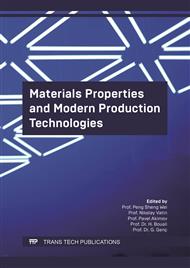[1]
R. Gehrmann, M.M. Frommert, G. Gottstein, Mater. Sci. Eng. A. 395 (2005) 338–349.
Google Scholar
[2]
N. Kamikawa, T. Sakai, N. Tsuji, Acta Mater. 55 (2007) 5873–5888.
Google Scholar
[3]
J. Hirsch, T. Al-Samman, Acta Mater. 61 (2013) 818–843.
Google Scholar
[4]
A.P. Boresi, R.J. Schmidt, O.M. Sidebottom, Wiley New York, (1985).
Google Scholar
[5]
M. Ardeljan, I.J. Beyerlein, B.A. McWilliams, M. Knezevic, Int. J. Plast. 83 (2016) 90–109.
Google Scholar
[6]
J. Segurado, J. Llorca, Comput. Mater. Sci. 76 (2013) 3–11.
Google Scholar
[7]
M. Bertin, C. Du, J.P.M. Hoefnagels, F. Hild, Acta Mater. 116 (2016) 321–331.
Google Scholar
[8]
D. Raabe, D. Ma, F. Roters, Acta Mater. 55 (2007) 4567–4583.
Google Scholar
[9]
A.A. Salem, S.R. Kalidindi, S.L. Semiatin, Acta Mater. 53 (2005) 3495–3502.
Google Scholar
[10]
A.S. Khan, J. Liu, J.W. Yoon, R. Nambori, Int. J. Plast. 67 (2015) 39–52.
Google Scholar
[11]
W. Woo, V.T. Em, E.Y. Kim, S.H. Han, Y.S. Han, S.H. Choi, Acta Mater. 60 (2012) 6972–6981.
Google Scholar
[12]
W.G. Feather, D.J. Savage, M. Knezevic, Int. J. Plast. 143 (2021) 103031.
Google Scholar
[13]
H. Lim, et al., J. Mech. Phys. Solids. 74 (2015) 80–96.
Google Scholar
[14]
S. Breumier, S. Sao-Joao, A. Villani, M. Lévesque, G. Kermouche, Mater. Des. 193 (2020) 108789.
DOI: 10.1016/j.matdes.2020.108789
Google Scholar
[15]
W. Li, S Hamada, H Noguchi, Fatigue Fract Eng Mater Struct. 45 (2022) 1406–1420.
Google Scholar
[16]
F. Roters, et al., Procedia IUTAM. 3 (2012) 3–10.
Google Scholar
[17]
N. Jia, F. Roters, P. Eisenlohr, C. Kords, D. Raabe, Acta Mater. 60 (2012) 1099–1115.
DOI: 10.1016/j.actamat.2011.10.047
Google Scholar
[18]
N. Jia, P. Eisenlohr, F. Roters, D. Raabe, X. Zhao, Acta Mater. 60 (2012) 3415–3434.
DOI: 10.1016/j.actamat.2012.03.005
Google Scholar
[19]
F. Roters, et al., Comput. Mater. Sci. 158 (2019) 420–478.
Google Scholar
[20]
N. Jia, D. Raabe, X. Zhao, Acta Mater. 76 (2014) 238–251.
Google Scholar
[21]
L Kubin, B Devincre B, T Hoc, Acta Mater. 56 (2008) 6040-6049.
Google Scholar
[22]
S.L. Wong, M. Madivala, U. Prahl, F. Roters, D. Raabe, Acta Mater. 118 (2016) 140–151.
DOI: 10.1016/j.actamat.2016.07.032
Google Scholar
[23]
T Takeuchi. Trans Jpn Inst Met. 17 (1976) 313-321.
Google Scholar



